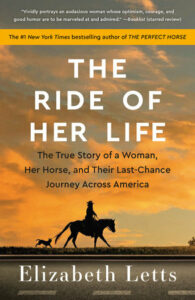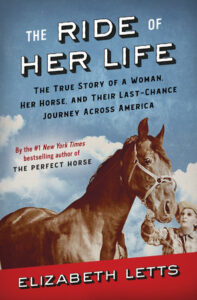
Pioneering feminist’s pilgrimage offers a birds-eye-view of the first-half of 20th century America (From Minot, Maine to North Hollywood; 1954 – 1956): Bravo to horsewoman Elizabeth Letts for living up to her reputation for impressive research skills, having won the PEN Center Literary Award for Research Nonfiction in 2017 for The Perfect Horse: The Daring U.S. Mission to Rescue the Priceless Stallions Kidnapped by the Nazis. The same can be said of her 2011 debut The Eighty-Dollar Champion. For The Ride of Her Life: The True Story of a Woman, Her Horse, and Their Last Chance Journey Across America, Letts logged 10,000 research miles by car using “1950s vintage gas station maps” to trace, uncover, and piece together a death-defying 5,000 mile East-to-West coast daredevil saga, pulled off by one woman powered by an indefatigable horse and companion dog in the 1950s. The stuff of legends.

As a novelist (Finding Dorothy, the most recent), history comes alive through Letts’ appealing, novelistic prose. In the telling of the realization of an against-all-odds dream of reaching California’s “land of sunshine” from a remote Maine farm by horse that took over a year, the book becomes more than one woman’s extraordinary tale to social and cultural commentary of an America at the cusp of sweeping changes.
Letts visited historical societies in small towns across America digging up fascinating details that put context, humanity, and history into this life-affirming book that speaks volumes about the bond between horses, dogs, and humans, and a can-do spirit at an historical time when Americans weren’t so fearful, distrustful of strangers. The three vagabonds they opened their farms, barns, homes, ranches, and jail cells to are:
- Annie Wilkins: 62-year-old Maine single farmer diagnosed with TB expected to live only two to four years. Hadn’t stepped foot outside the state, except briefly as a child. Embodies Maine’s independent spirit.
- Tarzan: Morgan horse Annie rescued. Known for being “reliable, loyal, tireless, and versatile.” Purchased with the little money Annie made from the sale of her family’s farm she inherited during the Great Depression.
- Depeche Toi: French-Canadian named, Dachshund mix.
Annie’s mother put the California fantasy into her head as a child regaling her with optimistic stories, an escape from the hard life of a Maine farm that saw its productivity dwindled to a bare-minimum. It took more than courage and foolhardiness to set off on a horse you hadn’t gotten to know, let alone ride one in over thirty years. But that’s what Annie did. With her life expectancy in the balance and an adamant refusal to be a burden to the state or anyone, Annie unknowingly bought the perfect horse. With one hand on the saddle and the other holding a rope tethered to her low-lying, energetic little dog running alongside Tarzan and Annie atop, this threesome became a formidable “team.” “Clip-clopping” at the pace of three to four miles an hour, they shared newly constructed turnpikes (and backroads) with cars and trucks whizzing by when a “single older woman without family or employment faced few and stark choices.” And yet, Annie found one.
Dressed like a man wearing four layers of clothing gave her some protection, but her health was still seriously compromised. Without knowing from day to day where they’d all sleep, how they’d eat, or what was ahead, Letts charts this herculean feat, state by state.
Blessed with the “love, loyalty” of “four-footed guides,” Annie had one other crucial thing going for her she never expected and we’re treated to: an amazing string of “kindness and generosity” by strangers who soon learned of the intrepid travelers, seeing them through the windows of their newfound love affair with the automobile. The year 1954 “was a banner year,” Letts annotates. “That year, the average price of a car was $1,700 . . . In contrast the equine population plunged drastically in the same decade.” Annie’s America was “quickly moving from agrarian and rural to urban and suburban.”
It took months for Annie and her two unflagging animals to make their way into Kentucky horse country. From there, they traveled into Tennessee and Arkansas, no further south. Notable because of the absence of Annie’s meeting anyone of color. Letts is mindful of that, reminding us that the Civil Rights Act wasn’t passed until 1964, expanded in ’68, concluding: “Annie must have known that in the 1950s, Black travelers would not have been so welcome everywhere.”
It didn’t take long for news of this strikingly odd crew to spread, after a reporter discovered them. From local newspapers to the AP newswire, Annie and her animals gained notoriety. Annie, though, wasn’t the type to seek fame. Treating everyone the same is one reason we become so fond of her.
This lonely woman didn’t feel alone with her devoted horse and dog by her side, but her dazzling storytelling had a snowball effect surrounding them with people as they were invited and cheered on at county fairs, town parades, and the “biggest rodeo in America.” Sheriffs, police, and citizens looked out for her and her companions. She meets Andrew Wyeth, the painter. Veterinarians replace Tarzan’s constantly worn-down shoes. Passionate “horse people” provided food and shelter for the trio; some invited all to stay as long as Annie wanted. She meets widows like Mrs. Casey Jones of railroad lore, and widowers who see how exceptional she is like an 80-year-old Wyoming rancher who asked her to marry him. Tempting but not desirable after two ex’s abandoned her to deal with the worthless farm, the dream far more important “than any man.” Even when sought out as a contestant on Art Linkletter’s long-running TV show, People Are Funny, Annie took celebrity in stride.
Stardom did help her. An empathetic soul gave her the idea to sell postcards she autographed, tiding her over.
The reader isn’t the only one who feels nostalgic for Main Streets, “F. W. Woolworth’s five-and-dime” stores, drugstores equipped with soda fountains. “In the early part of the twentieth century, there was an upsurge in nostalgia about America’s pioneer past,” Letts affirms. “In 1955, her story ratcheted deep into the American psyche: her life alone on a small farm, her horse, her dog, her fearlessness and determination.” It’s uplifting when anyone discovers the freedom to choose their destiny.
Weather, though, was a formidable foe acting like a character wreaking havoc, resonating today when extremes of climate can no longer take a back seat. For months, they journeyed in wintery conditions – hazardous icy pavements for the walkers and drenched clothing for the older woman with weak lungs – and still they overcame a litany of mishaps and setbacks.
“If you want to go fast, go alone. If you want to go far, go together” is one of the meaningful quotes serving as epigraphs above chapters. In Wyoming, it’s said another way: “That cowboy who rides off alone in the sunset? He wasn’t alone. He was on horseback. And that is what it is to be a rider. Your best friend is always with you.”
Bravo to the horsewoman, historian, novelist, and nonfiction pro.
Lorraine